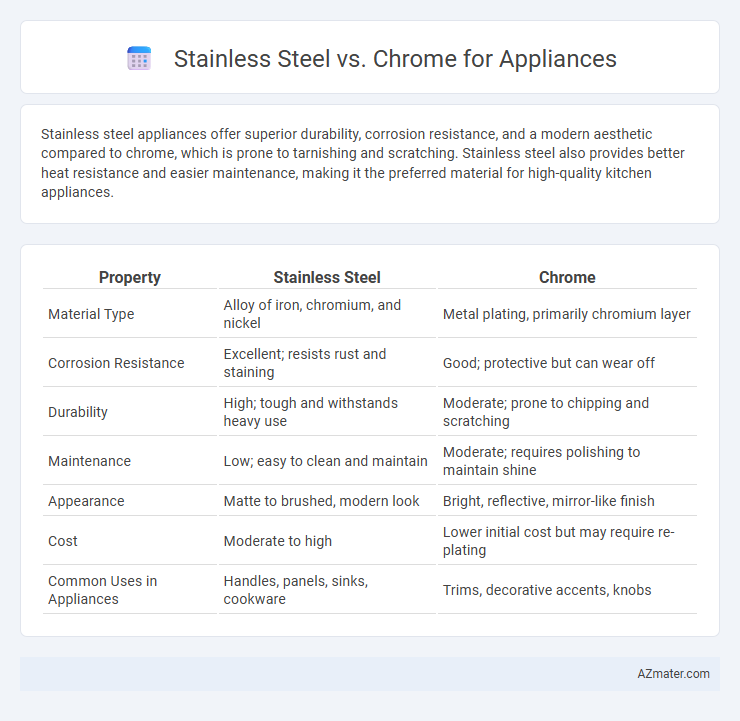Stainless steel appliances offer superior durability, corrosion resistance, and a modern aesthetic compared to chrome, which is prone to tarnishing and scratching. Stainless steel also provides better heat resistance and easier maintenance, making it the preferred material for high-quality kitchen appliances.
Table of Comparison
| Property | Stainless Steel | Chrome |
|---|---|---|
| Material Type | Alloy of iron, chromium, and nickel | Metal plating, primarily chromium layer |
| Corrosion Resistance | Excellent; resists rust and staining | Good; protective but can wear off |
| Durability | High; tough and withstands heavy use | Moderate; prone to chipping and scratching |
| Maintenance | Low; easy to clean and maintain | Moderate; requires polishing to maintain shine |
| Appearance | Matte to brushed, modern look | Bright, reflective, mirror-like finish |
| Cost | Moderate to high | Lower initial cost but may require re-plating |
| Common Uses in Appliances | Handles, panels, sinks, cookware | Trims, decorative accents, knobs |
Introduction to Stainless Steel and Chrome Appliances
Stainless steel appliances feature a durable, corrosion-resistant alloy composed primarily of iron, chromium, and nickel, known for its sleek, modern appearance and ease of cleaning. Chrome appliances, coated with a thin layer of chromium plating, offer a reflective, polished finish that resists tarnishing and provides a high-gloss aesthetic. Both materials enhance appliance longevity and style, with stainless steel favored for its robustness and chrome prized for its vibrant shine.
Material Composition: Stainless Steel vs Chrome
Stainless steel appliances are primarily composed of iron, carbon, and chromium, with the chromium content typically around 10-20%, providing corrosion resistance and durability. Chrome plating consists of a thin layer of chromium electroplated onto a metal substrate, usually steel or brass, offering a shiny finish but less resistance to scratches and corrosion compared to stainless steel. The solid composition of stainless steel makes it more robust and long-lasting, while chrome's decorative finish requires maintenance to preserve its appearance.
Aesthetic Appeal and Design Versatility
Stainless steel offers a sleek, modern look with a matte finish that resists fingerprints and smudges, enhancing the aesthetic appeal of contemporary kitchens. Chrome provides a high-gloss, reflective surface that adds a touch of elegance and luxury, allowing for more versatile design elements in both classic and modern settings. The durability and corrosion resistance of stainless steel make it a practical choice for appliance exteriors, while chrome's polished shine suits decorative accents and fixtures, balancing function and style effectively.
Durability and Longevity Comparison
Stainless steel offers superior durability with its resistance to rust, corrosion, and heat, making it ideal for appliances exposed to moisture and frequent use. Chrome plating provides a polished, shiny finish but is more susceptible to chipping and tarnishing over time, reducing its overall longevity. Appliances with stainless steel surfaces typically maintain their appearance and structural integrity longer than chrome-coated counterparts in demanding kitchen environments.
Maintenance and Cleaning Requirements
Stainless steel appliances require routine cleaning with mild soap and water to prevent fingerprints and smudges, while specialized stainless steel cleaners help maintain their corrosion-resistant finish. Chrome appliances are prone to water spots and tarnishing, demanding frequent polishing with chrome-specific cleaners or a mixture of vinegar and water to preserve their shine. Both materials benefit from regular wiping with a soft cloth to avoid scratching and maintain their aesthetic appeal.
Resistance to Rust, Corrosion, and Scratches
Stainless steel appliances offer superior resistance to rust and corrosion due to their high chromium and nickel content, making them ideal for humid or wet kitchen environments. Chrome finishes, while visually appealing with a reflective surface, are more prone to scratching and may develop rust over time if the protective plating is compromised. Choosing stainless steel ensures long-lasting durability and minimal maintenance, especially in high-use appliances exposed to moisture and cleaning agents.
Cost Differences and Budget Considerations
Stainless steel appliances typically cost more upfront due to higher material quality and durability, averaging 10-20% above chrome finishes. Chrome appliances are more budget-friendly but may require frequent maintenance and show fingerprints easily, increasing long-term costs. Budget considerations should balance initial investment with potential upkeep expenses when choosing between stainless steel and chrome.
Impact on Kitchen Resale Value
Stainless steel appliances are highly favored in modern kitchens for their durability, sleek appearance, and resistance to fingerprints and smudges, significantly boosting kitchen resale value. Chrome finishes, while shiny and visually striking, tend to show fingerprints and scratches more easily, potentially detracting from long-term appeal and resale prospects. Real estate experts consistently report that homes with stainless steel appliances tend to attract higher offers and sell faster compared to those featuring chrome, due to perceived quality and timeless style.
Environmental Impact and Sustainability
Stainless steel appliances offer greater sustainability compared to chrome due to their recyclability and longer lifecycle, reducing environmental waste. Stainless steel is composed primarily of iron, chromium, and nickel, materials that can be efficiently recycled without losing quality, which helps lower carbon footprints in manufacturing. Chrome finishes, often requiring more frequent replacement due to corrosion and wear, generate higher environmental costs from resource extraction and disposal, making stainless steel the more eco-friendly choice for appliances.
Choosing Between Stainless Steel and Chrome for Your Home
Stainless steel appliances offer exceptional durability, resistance to rust and fingerprints, and a sleek, modern look that complements most kitchens. Chrome finishes provide a highly reflective, polished surface that enhances aesthetic appeal but may require more frequent cleaning to maintain shine. Choosing between stainless steel and chrome depends on your preference for low maintenance and durability versus a shiny, decorative finish that adds a touch of elegance to your home.

Infographic: Stainless steel vs Chrome for Appliance
 azmater.com
azmater.com